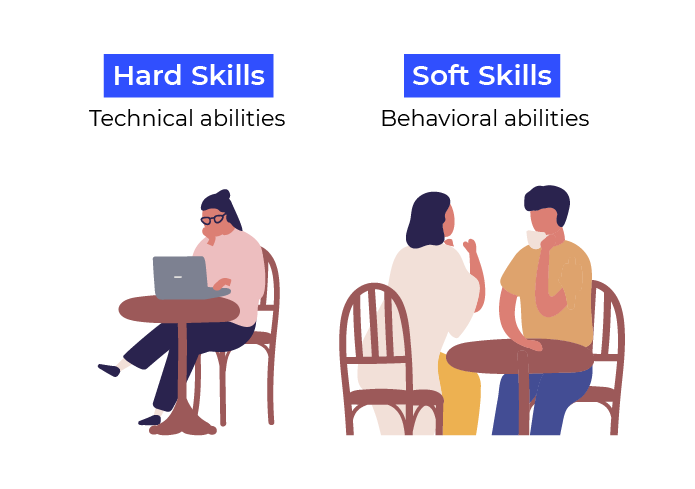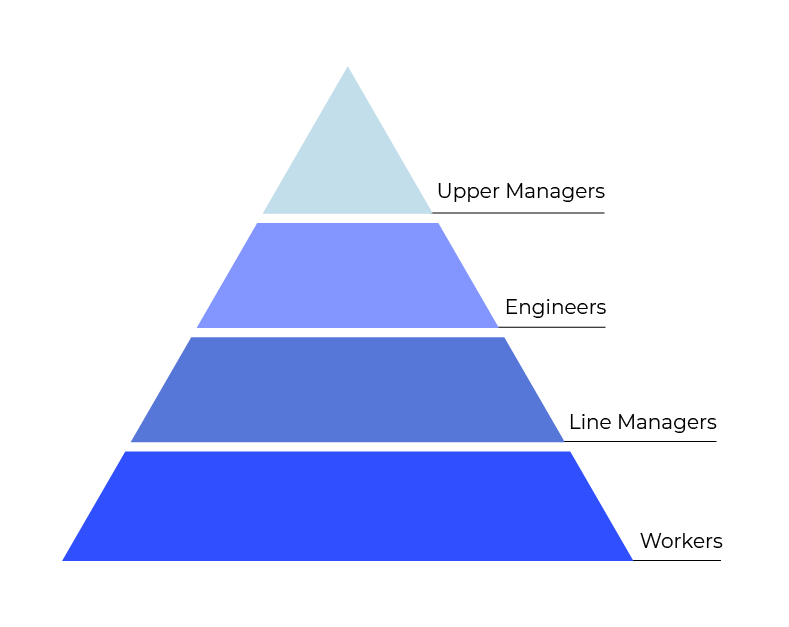In the first part of this course, you learned how digital impacted the professional world.
In this part, we'll dive deeper into three main changes that have had the most consequential impact on the modern workplace:
The customer-centric approach, which transformed how products are developed and how new market opportunities are identified.
The power of data - you'll discover why data is such a game changer and learn how technology can help you make better-informed decisions.
The new ways of working that will help you be more agile and efficient in designing new solutions.
In addition to learning new vocabulary, you'll discover that you can easily apply these concepts to your work life and that they'll enable you to look at problems from a different angle.
Before delving into these changes, let’s look at one of the fundamental pillars of working in a digital world: soft skills.
Develop Your Soft Skills
A 2020 study by the World Economic Forum found that today’s kindergarten students will have no fewer than nine different careers in their life—and most don’t even exist yet!
So what can you do to adapt to the new demands of the professional world?
Develop your soft skills, that’s what!
Soft skills? 🧐
Soft skills are behavioral and interpersonal skills, such as emotional intelligence or empathy. They are acquired, developed, and used in all aspects of life.
Many contrast soft skills with hard ones, also known as technical skills—the tangible skills that were front and center of our jobs and résumés for a long time. And yet you’ve used soft skills in your work life, perhaps without even knowing it!

Time to Play!
Can you tell a hard skill from a soft skill? Place each skill in its corresponding column in the table below:
Negotiating a deadline diplomatically.
Calculating a budget.
Coming up with a solution to a new problem.
Putting yourself in your customers’ shoes.
Managing a customer database.
Managing social media accounts.
Piloting a drone.
Practicing critical thinking.
Soft skills | Hard skills |
|
|
|
|
|
|
|
|
Here’s a (non-exhaustive) list of soft skills that will be most in demand, according to the World Economic Forum’s The Future of Jobs Report, which I’ve mentioned before:
Complex problem-solving
Critical thinking
Creativity
Leadership and managing teams
Emotional intelligence
Decision-making
Customer service
Negotiation
Resilience and flexibility
Why is it important to develop soft skills?
They are easily transferable from one career to another.
Unlike technical skills, they don’t become obsolete.
They develop intellectual and emotional agility.
And finally, they are becoming more and more sought after!
Soft skills | Hard skills |
Negotiating a deadline diplomatically | Calculating a budget |
Coming up with a solution to a new problem | Managing a customer database |
Putting yourself in your customers’ shoes | Managing social media accounts |
Practicing critical thinking | Piloting a drone |
Choose to Work Collaboratively
Did you know that you can be more creative, make better decisions, and feel better at work when working with others?
Sure, it’s easier said than done... Especially in a world where the workplace is still largely structured by the division of labor, passed down from Adam Smith (dating from the 18th century!) to Taylorism, keeping work stratified and siloed: engineers and managers on one side, line workers on the other.
Why is that? Well, Taylorism does have advantages, such as increased output and efficiency.

Even today, most organizations are still structured according to Taylor’s famous pyramid, with the biggest corporations often having ten levels or more.
When you think about it, doesn’t it seem crazy that modern businesses are still operating based on centuries-old theories?
Especially when we know that modern ways of organizing the workplace exist, with the promise of a more open organizational structure — this means rethinking ways of working and collaborating to allow for a more agile company and one that performs better. Most of the time, this is excellent news for employees, who gain a greater sense of meaning, autonomy, and overall well-being at work.
The good news is that embracing digital can help you better adapt to these changes. By giving workers tools for sharing information and facilitating communication between as many people as possible, digital adoption has made undeniable values such as collaboration, transparency, horizontality, and freedom of expression. The work culture everywhere has changed as a result.
But how can a company actually foster collaborative work?
Great question! Here are a few easy solutions to implement:
1. Encourage information sharing
Develop transparency
Encourage everyone to contribute to decision-making
Avoid information silos, especially:
Between levels of hierarchy
Between departments
With business partners
2. Put digital tools in place to facilitate information sharing
Workplace, a Facebook for the office
Slack, the messenger app for asynchronous communication
Trello, for project and task management
The Google Workspace suite, which lets multiple people work on the same documents
Microsoft Teams, which is by far the tool most commonly used in large corporations
You have probably used some of these already!
3. Emphasize teamwork in corporate values and HR performance standards
Promote an atmosphere of collaboration starting at the top
Place value on collective performance
Simplify internal mobility
Experiment With the Test and Learn Approach
“If you are not embarrassed by the first version of your product, you’ve launched too late.” Reid Hoffman
This quote from the founder of LinkedIn should give you an idea of the logic behind the test and learn approach. This method is commonly adopted by start-ups, and it dares us to take bold leaps.
Test and learn encourages you to launch the first version of your product and get it into users' hands as soon as possible so that you can improve it quickly, using the users' feedback.
But how does that work in the real world? 🤨
You have to break it down into three stages:
Test one or more ideas.
Analyze the results of those tests.
Apply what you’ve learned to your product or idea and start over!
You can apply this method to any number of projects. The main benefit of this approach is feedback. You’ll get test results to analyze and concrete, real-world user experiences to draw from.
But what if the tests go wrong? 😨
That’s not a bad thing—actually, it’s quite the opposite! Think of how much time and money you’ll save for your team, not to mention the lessons you’ll learn from the tests, which will help you avoid making the same mistakes later.
In short, the test and learn approach encourages you to accept and grow accustomed to failure. Failure lets you grow, try again, and develop your resilience, both personally and as a group.
One last bit of advice: remember the famous mantra:
“Fail fast and learn faster.”
(in French: “échoue rapidement, et apprend encore plus vite”)
This is the perfect segue to the final section of this chapter: continuous learning.
Adopt a Continuous Learning and Improvement Approach
Did you know that the lifespan of technical skills is getting shorter? This trend confirms that people need to keep learning new things throughout their lives.
Anything you do to improve your skills and learn new ones, formally or informally, is called lifelong learning.
And there are three ways to do this:
Hard skills | Soft skills |
1. Updating the skills you've already acquired, especially technical skills | 3. Learning new attitudes and new ways of doing things |
2. Learning new skill sets |
|
At the heart of it is one skill that will help you evolve and grow: learning to learn.
Learning to learn? 😳
That’s right—learning is a fundamental skill that’s become crucial in a world where it’s common to jump between different careers, as you saw in the first part of the course.
I don’t know about you, but education was mostly an obligation in my earlier years.
But we are now in the era of self-education. Sure, we get some training from work, but self-education goes beyond that.
When I take a training course, I’m increasing my employability capital, which will follow me throughout my professional journey.
More good news: self-education has never been easier—and it’s all thanks to technology!
YouTube, podcasts, webinars, and social media networks like LinkedIn and Google offer certified training programs, and many major universities worldwide offer online courses. There’s a vast amount of content out there, and it’s often free.
So, what will you learn when this course is over?
Let’s Recap!
Developing soft skills has become crucial for adapting to changes in your current career and improving your future employability since these skills are transferable from one job to another and are highly sought after by employers.
You must keep learning continuously throughout your life to improve your soft skills and stay employable.
Work has become increasingly collaborative, and the corporate pyramid structure is crumbling. Collaborative work improves agility and performance and helps workers feel more engaged.
The new ways of working are less focused on striving for perfection. The test and learn approach allows for agility and innovation while taking measured controlled risks.
Now you know why you should develop your soft skills and how companies must adapt to the new ways of working in the digital age. I’ll see you in the next chapter, where you’ll learn how to make the customer your focus!
